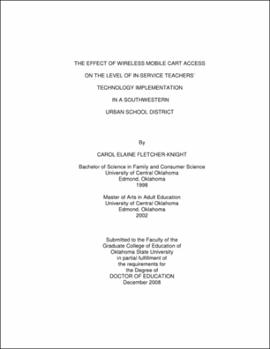| dc.contributor.advisor | Stansberry, Susan L. | |
| dc.contributor.author | Fletcher-Knight, Carol Elaine | |
| dc.date.accessioned | 2013-11-26T08:34:27Z | |
| dc.date.available | 2013-11-26T08:34:27Z | |
| dc.date.issued | 2008-12 | |
| dc.identifier.uri | https://hdl.handle.net/11244/7396 | |
| dc.description.abstract | Scope and Method of Study: | |
| dc.description.abstract | The site of this study was a K-12 Urban School District located in a Southwestern city in the United States. This quantitative study employed cross-sectional survey design method to investigate in-service teachers' level of technology implementation (LoTi) in classroom instruction following a multimillion dollar Wireless Mobile Laptop Cart deployment. Moersch (1995) developed the LoTi framework and the LoTiQ Survey. The LoTi framework is ground in Rogers (1995) Diffusion of Innovations Theory. Eighty-three in-service teachers participated by completing the LoTiQ survey online. | |
| dc.description.abstract | Findings and Conclusions: | |
| dc.description.abstract | Although 90 percent of teachers reported having access to the Wireless Mobile Cart, 60 percent indicated that they never used them. Analysis of teacher's verbatim comments concerning barriers to Wireless Mobile Cart use revealed that 71 percent of the barriers identified were Systemic/Organizational in nature, and proved to be more important for explaining non-use than access or lack of technology proficiency. | |
| dc.description.abstract | Key factors such as Wireless Mobile Cart Access (WMCA), Personal Computer Use (PCU-the indicator of teacher technology proficiency/efficacy), and Current Instructional Practice (CIP) that influence the level of technology implementation in classroom instruction were analyzed to determine if there was a relationship between these factors and teachers' Current Level of Technology Implementation (C-LoTi). CIP and PCU had a moderate and statistically significant relationship with the LoTi level and accounted for 37 percent of the variance in the C-LoTi. WMCA had a significant but weak relationship to C-LoTi. Although the majority of teachers were clustered at the higher intensity levels of PCU and CIP, 55 percent of teachers were clustered in the lower portion of the LoTi framework. Teachers had the requisite technology proficiency and instructional practices to perform at higher LoTi Levels. However, systemic barriers should be addressed to increase teachers' Wireless Mobile Cart use. | |
| dc.format | application/pdf | |
| dc.language | en_US | |
| dc.rights | Copyright is held by the author who has granted the Oklahoma State University Library the non-exclusive right to share this material in its institutional repository. Contact Digital Library Services at lib-dls@okstate.edu or 405-744-9161 for the permission policy on the use, reproduction or distribution of this material. | |
| dc.title | Effect of wireless mobile cart access on the level of in-service teachers' technology implementation in a southwestern urban school district | |
| dc.contributor.committeeMember | Ausburn, Lynna | |
| dc.contributor.committeeMember | McCharen, Belinda | |
| dc.contributor.committeeMember | Antonenko, Pasha | |
| osu.filename | FletcherKnight_okstate_0664D_10096 | |
| osu.accesstype | Open Access | |
| dc.type.genre | Dissertation | |
| dc.type.material | Text | |
| dc.subject.keywords | in-service teacher | |
| dc.subject.keywords | technology implementation | |
| dc.subject.keywords | technology integration | |
| dc.subject.keywords | technology use | |
| dc.subject.keywords | wireless computer cart | |
| thesis.degree.discipline | Teaching and Curriculum Leadership | |
| thesis.degree.grantor | Oklahoma State University | |
